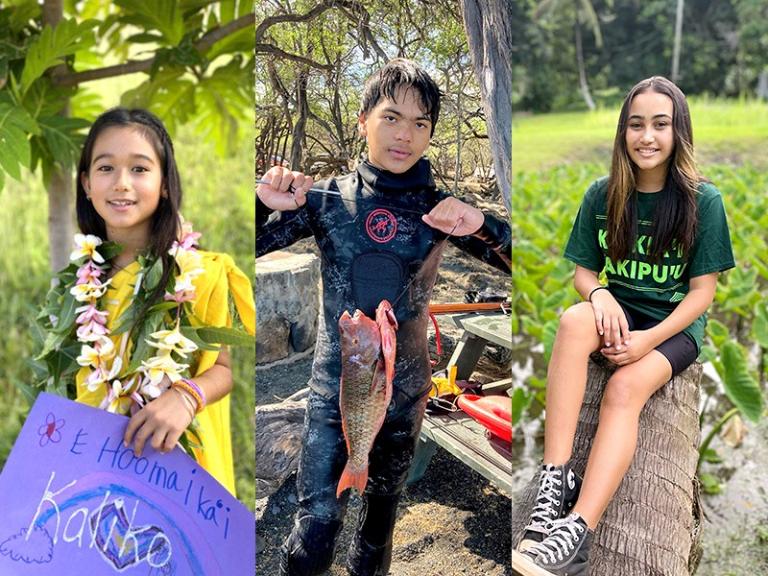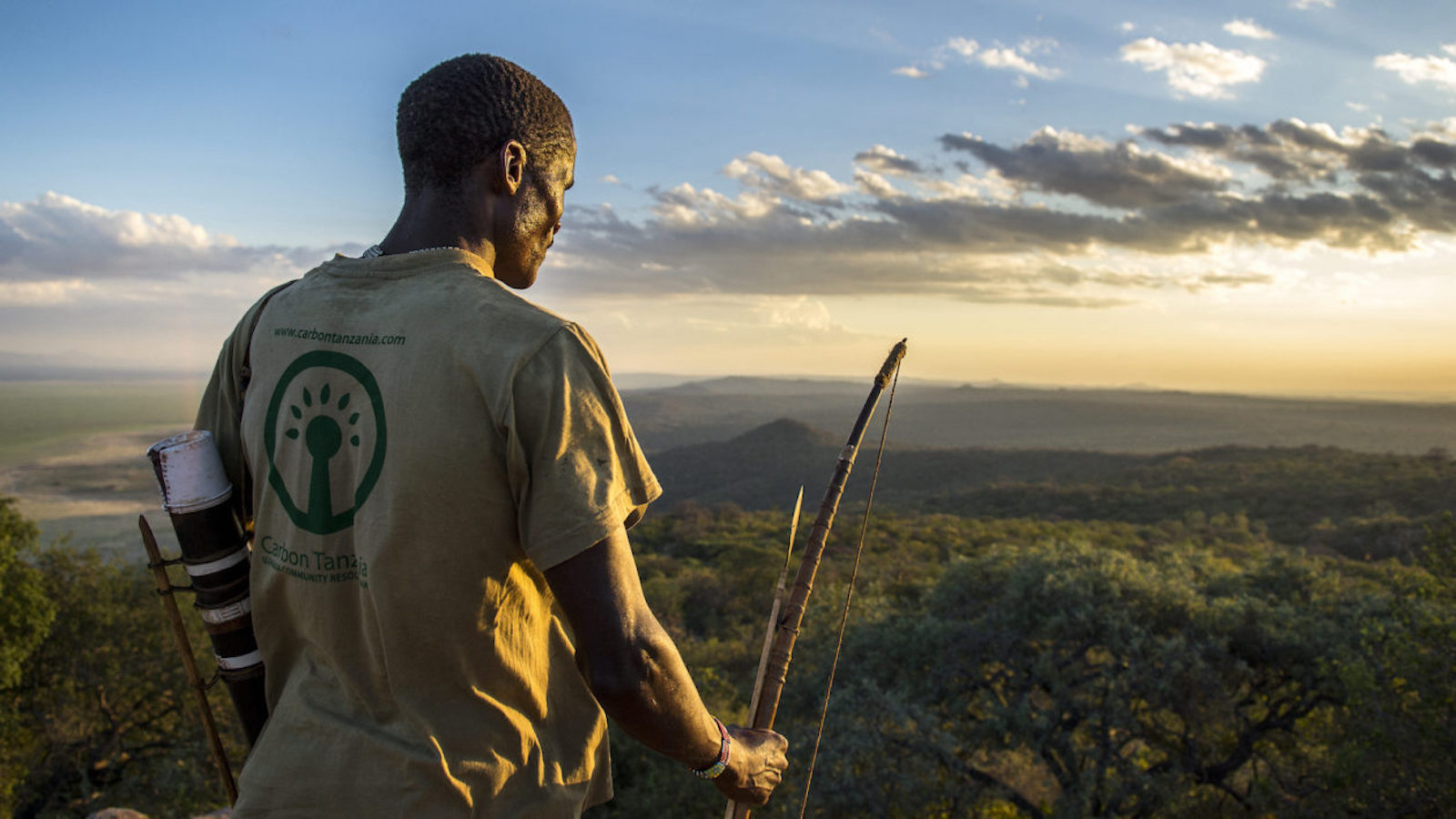This story was originally published by Yale Environment 360 and is reproduced here as part of the Climate Desk collaboration.
Deep in the Rift Valley of East Africa, close to some of the most ancient human remains ever unearthed, one of the continent’s last hunter-gatherer tribes is embracing 21st century environmentalism. The Hadza people, often called “the last archers of Africa,” are selling carbon credits generated from conserving their forests and using the revenues to employ their youths as scouts to keep forest destroyers away.
Starting this March, some 1,300 Hadza and members of the cattle-herding tribes with whom they share the Yaeda Valley of northern Tanzania, began receiving the first payments of what will be nearly half a million dollars annually from a local social enterprise, Carbon Tanzania, for protecting woodland hunting, and grazing grounds across an area larger than New York City.
The project will radically extend an existing decade-old carbon-offsetting initiative on Hadza land north to the edge of the Ngorongoro Conservation Area, one of Africa’s most iconic wildlife havens. But, unlike the Ngorongoro reserve, which was in part created by expelling local people, this project will embrace the skills of the hunting Hadza as custodians of the forests and friends of their wildlife.
Many believe that this form of community-based conservation can, besides its climate benefits, unlock new possibilities for protecting Africa’s wild places and the people and wildlife who depend on them. And they see it as a potential model for carbon offset projects not only in Africa but in other parts of the world.
In Tanzania, the locals are enthusiastic. They say the existing project helps them push back against outsiders keen to grab land for farming. “We are seeing a steady increase of some animal species like elephants passing through and in forest growth compared to the beginning,” says Christopher Shija, a scout recruited from Jobaj village. Moshi Isa, another scout who is from Mongo wa Mono village, notes, “The carbon project has strengthened our rights. And increased forest density is sustaining our hunting and gathering life.”
Foreign experts familiar with the checkered history of carbon offsetting agree. Carbon offset projects based on forest conservation are often criticized for failing to provide real carbon savings and simply shifting deforestation elsewhere; for riding roughshod over local forest communities; and for allowing Western companies to put off cutting their emissions. In Tanzania, most such projects have been “largely unconcerned” with the wellbeing of the local communities whose lands host them, according to Sebastién Jodoin, an environmental and land-rights lawyer from McGill University in Montreal. But of those he analyzed, the Yaeda Valley project was “the sole and important exception … designed and implemented in a manner that recognized the traditional rights and knowledge held by Indigenous Peoples.”
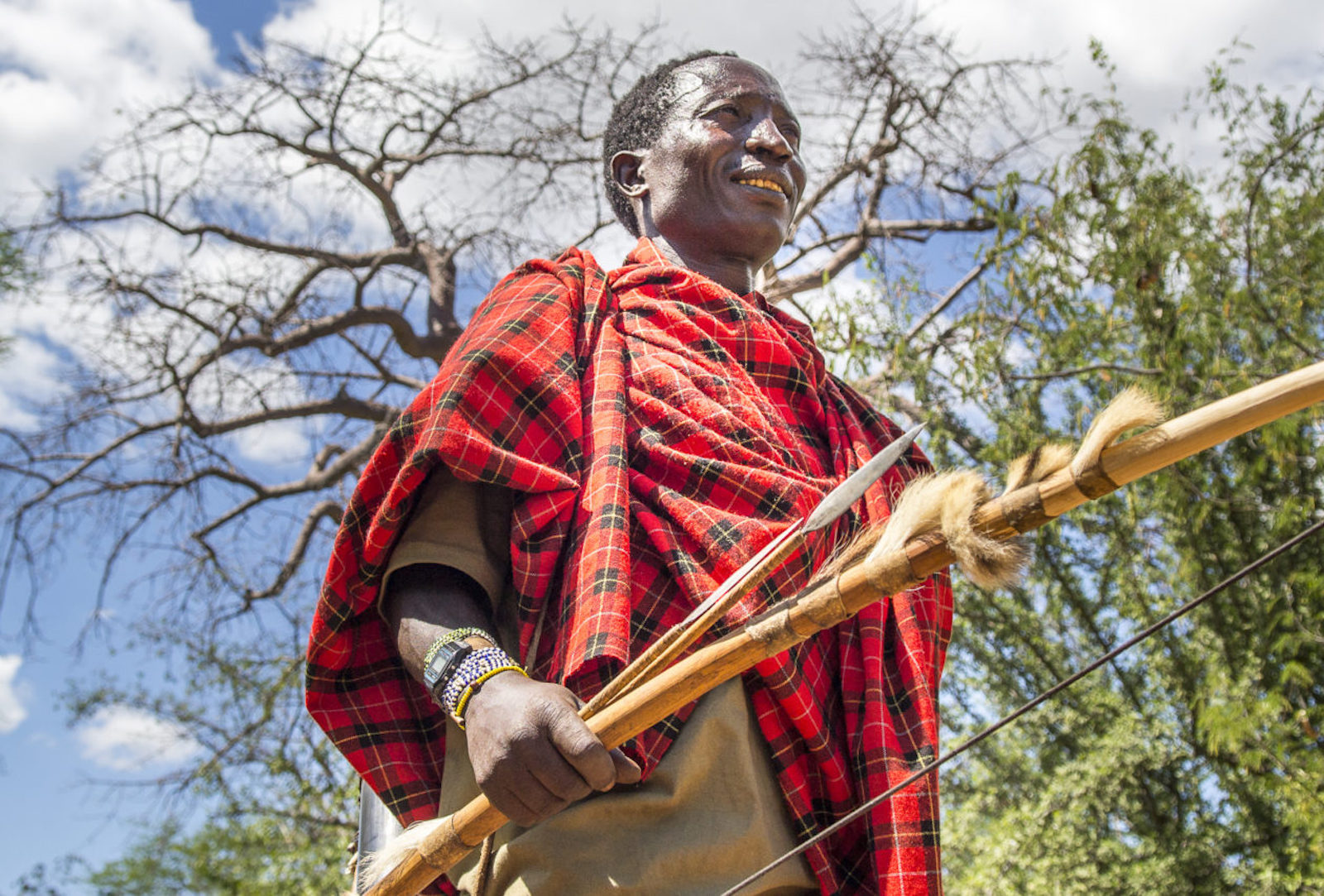
Without the projects, “the Hadza would really be on the brink. With it, they are in a more secure position than they have been for decades,” says Fred Nelson, CEO of Maliasili, an organization that supports community conservation projects across Africa. It is “probably the best such project in Africa.”
The Hadza have lived in northern Tanzania for at least 40,000 years. Their ancient ways of living off the land have become a magnet for researchers ranging from anthropologists to those studying healthy eating. Linguists are intrigued by their “click” language, which is spoken nowhere else.
Their land is a patchwork of wet grasslands and craggy hills covered in acacia and water-holding baobab trees. It harbors leopards, lions, gazelles, giraffes, antelopes, wild dogs, and Cape buffalo. The Hadza harvest wild fruits, tubers, honey, natural medicines, and bush meat, says Moshi, and visit sacred sites such as Dundubii, a hill topped with three stones that chime notes when struck.
But these territories have long been under threat. The Hadza have lost more than three-quarters of their traditional lands in the past half-century. Pastoralists bring their livestock onto the grasslands, especially in the dry season, and farmers clear forests to plow.
“Shifting agriculture is the primary driver of deforestation in the region, as in much of Tanzania,” says Jo Anderson, the co-founder and director of Carbon Tanzania. “It threatens the very existence of forest communities as well as Tanzania’s iconic wildlife.”
In the past, invasions have often been officially encouraged, says Anderson. Both in British colonial times and since the country’s independence in 1961, the nomadic ways of the Hadza were regarded by urban elites as an embarrassing cultural leftover. In the 1970s, they were subjected to a national policy of enforced settlement known as “villagization.” In 2007, the government announced plans to lease most of the Yaeda Valley to a hunting safari company from the United Arab Emirates.
But the tide has turned. Unexpected heroes in the story have been three American brothers — Daudi, Mike, and Thad Peterson. Raised in Tanzania, they had operated an early ecotourism business, Dorobo Safaris, before, in the 1990s, setting up and funding the Ujamaa Community Resource Team, or UCRT, an NGO helping villagers and Indigenous groups using Tanzanian land laws to secure legal title to their territories.
The UCRT’s Indigenous activists successfully campaigned against the planned Arab takeover of the Yaeda Valley. And in 2011 they secured title to about 50,000 acres, later expanded to 84,000 acres, of the Hadza’s ancestral lands, giving them the legal right to rebuff encroachers. The rights also brought responsibilities, and the UCRT then helped the Hadza, in consort with their pastoralist neighbors, to draw up land-use plans required by the Tanzanian government as a condition of title, zoning the territories for farms, housing, pastures, meeting grounds, cattle enclosures, water collection, and hunting grounds and setting aside some lands for nature.
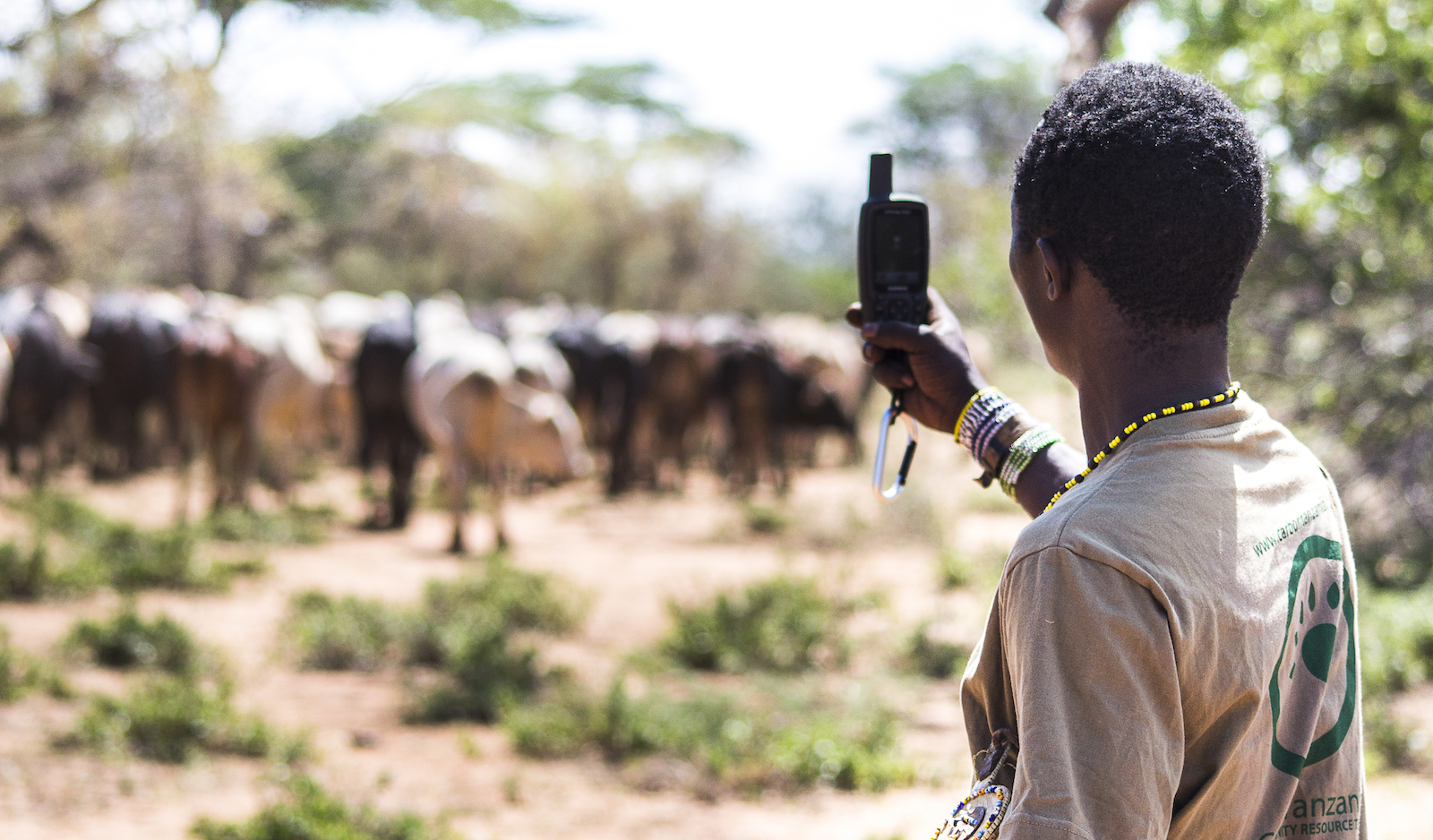
The UCRT today takes in money from other donors, including The Nature Conservancy, and has achieved land rights on more than 1.5 million acres of pastures and forests for around a hundred local communities across Tanzania.
Along the way, the UCRT’s work attracted a young British volunteer, Jo Anderson, who proposed helping the Hadza earn money from their newly acquired land rights by protecting the forests from invaders and selling the resulting carbon credits in the UN-backed market known as Reducing Emissions from Deforestation and Forest Degradation in Developing Countries or REDD+.
In partnership with the UCRT and the Hadza representatives it had cultivated, Anderson, with colleague Marc Baker, set up Carbon Tanzania and started to sell carbon credits from the Hadza’s titled land in 2013. The initial project employed 20 youth as scouts who gathered data on their forests and policed incursions. Many of the offsets were purchased by travel companies, including Africa-based ecotourism outfits looking to offset the emissions produced by their customers. In the first seven years, independent auditors estimated that the project captured an average of 22,000 tons of carbon dioxide annually and channeled $490,000 in revenues from carbon-credit sales to communities.
In 2016, the UCRT succeeded in increasing the titled area to 590,000 acres of forest and pasture, divided between the Hadza and their sometimes-rivals for land, the pastoralist Datoga people. In December that year, the country’s then minister of lands, William Lukuvi, traveled to Hadza country to issue the titles in person, a move widely seen as signaling that the government now saw the Hadza as a valuable and treasured part of the nation.
This became the basis for an expanded 273,000-acre Yaeda-Eyasi Landscape REDD+ Project, involving nine other communities and stretching from the Yaeda Valley north, beyond Lake Eyasi to the edge of the Ngorongoro Conservation Area, part of the Serengeti savanna ecosystem. It now employs 57 people, mostly scouts trained in forest protection, wildlife monitoring, and using smartphones for mapping. Anderson says it should prevent the felling of more than 170,000 trees annually, resulting in some 177,000 tons of avoided emissions for sale as carbon credits. The main buyer of the credits in the expanded project is MyClimate, a German offset company.
Demonstrating the environmental gains that justify the sale of the carbon credits has been a challenge, says Anderson. It involves assessing both changes in the carbon in the forests and what would have happened without the project. “Measuring the carbon is easy,” he says. “The hard bit is modeling the counterfactual baseline, and demonstrating that deforesters did not just go somewhere else, with no overall carbon benefit.”
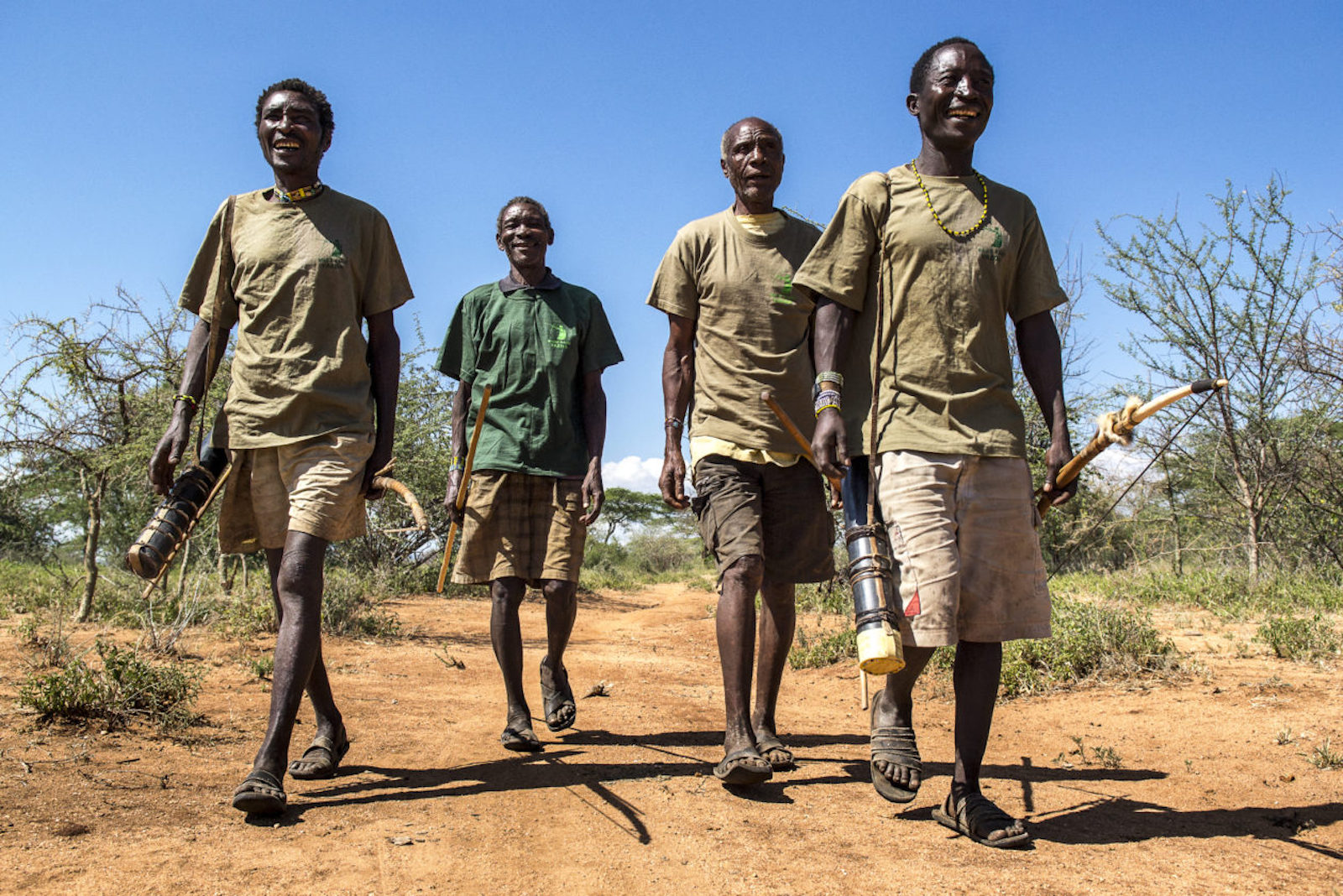
At least 60 percent of the revenues from credit sales go directly to the communities, with the remainder going for project monitoring and overhead. In the Hadza case, their money arrives into village bank accounts and via mobile-phone money transfers to the scouts. In March this year, Anderson handed over to the 12 villages involved in the expanded project area a down payment of $90,000 on an anticipated annual payment of $450,000.
The communities meet twice each year to decide how to spend the money, says Hadza project manager Isack Bryson, a local villager who gained a biology degree before returning to work for Carbon Tanzania. Priorities for the Hadza, he says, include paying for school fees and medical care, sending new scouts for conservation training, buying maize meal to supplement their hunter-gatherer diets, and running village administration. There are building projects too, including supplying sanitation and electricity for local schools.
Datoga cattle herders have used the money for water troughs and dams to supply their animals, says their project manager German Sedoyeka from Qangdend village.
Whether the payments continue as planned depends, of course, on the village scouts and their ability to police the land and stem deforestation. They cheerfully accept the role. “My job is to ensure forests and wildlife are secured and safe, and stop illegal migrants to the forest area. I report to the village executive officer for fines and evictions,” says Shija. But he in turn relies on the eyes and ears of villagers and hunters out in the forests. “The community inform me of any forest damage. They perceive me a very important person,” he says with some pride.
The scouts say they have seen the benefits for wildlife since the original carbon project began. “The abundance of wild species such as giraffes, zebra, elephants, and cheetahs, has been progressively increasing,” says Moshi. Academics agree. A detailed four-year study of the Yaeda Valley, carried out by Tanzanian and American researchers and published in 2019, found, in particular, rising numbers of giraffes and other browsers of woody vegetation.
As well as benefiting local biodiversity, the growing number of antelopes and other bush meat species helps maintain and revive Hadza hunting traditions. “Hunting is greater than a few years ago,” says Moshi. Does he ever hunt while out on his conservation patrols? “No, I never hunt during our official days on patrol,” Moshi insists. Preventing poaching by outsiders is, after all, one of his main tasks. “But when I am not doing my official job, you can see me going to hunt, because it is my tradition. I very like.”
The outside world continues to encroach. Tourists increasingly drive south from Ngorongoro, which has an estimated 750,000 visitors annually, to see the colorful tribe they have read about. Some anthropologists have questioned whether these visits are turning the communities they visit into demeaning exhibits. But a more optimistic scenario holds that, with secure land rights and income from selling carbon credits, the Hadza and their neighbors will be more in charge of events. “Tourism offers opportunities for community benefits,” Bryson says.
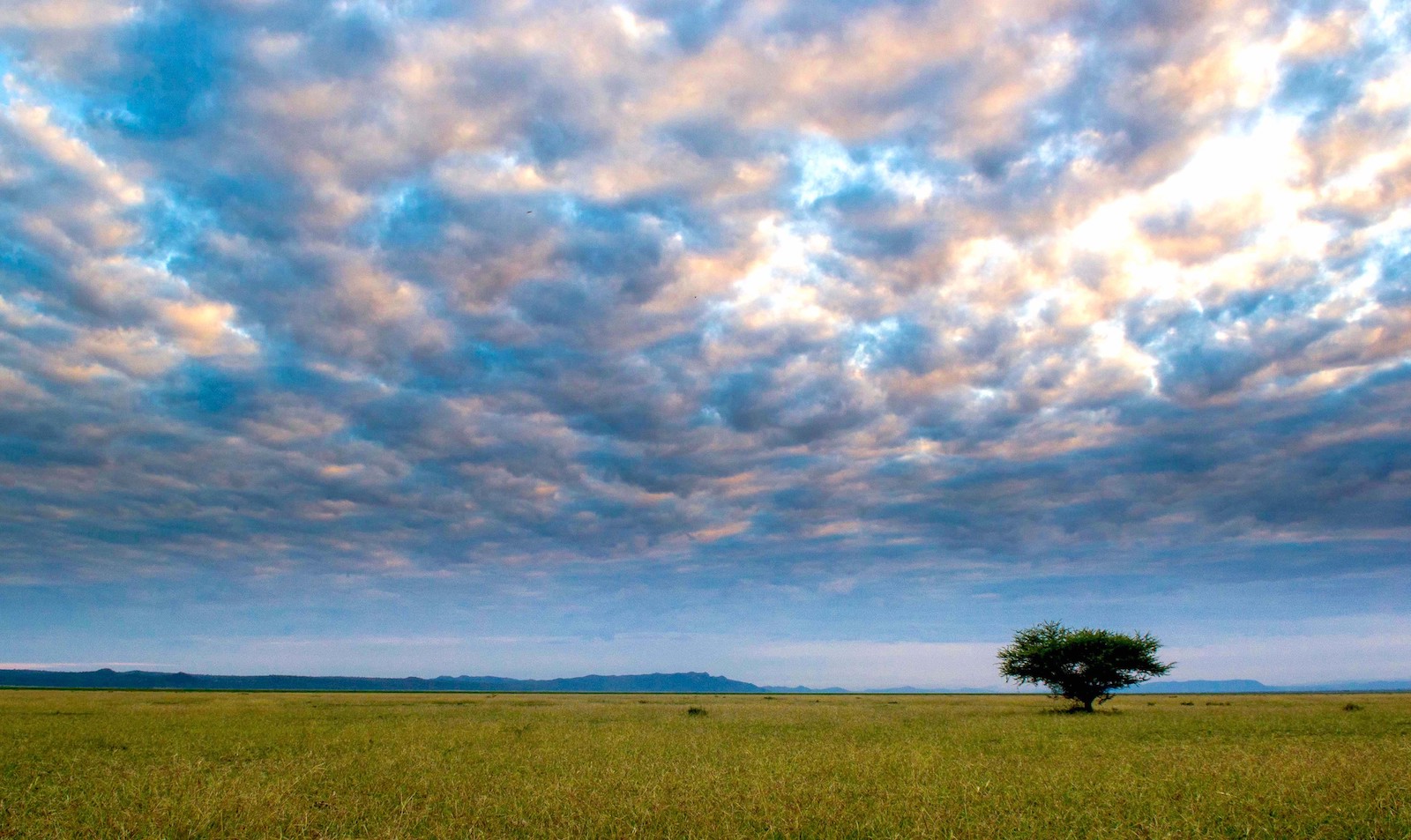
However it plays out, the conservation going on in the Yaeda and Eyasi valleys is very different from traditional methods built around banishing pastoralists and other communities or severely curtailing their means of living off the land. Here local people are the custodians of their land and its wildlife, rather than being seen as a threat.
Anderson says Carbon Tanzania’s methods can expand the agenda of conservation beyond national parks and biodiversity hotspots. He remembers that “as a young naturalist traveling in Tanzania, I saw massive areas of bush outside areas deemed worthy of conservation. Mostly they were community-run forests amid the farms and pastures — vital to local communities but undervalued by outsiders.”
Beside the Yaeda Valley, Carbon Tanzania runs carbon-offsetting projects based on community conservation in Tanzania’s Makame grasslands and Ntakata Mountains. Now it is eyeing another neglected area of bush in the country’s remote southern borderland, between the Nyerere National Park and Mozambique’s giant Niassa Nature Reserve. Together, the two protected areas cover more than 17 million acres, but between them there is a gap of more than 5 million acres of unprotected woodlands occupied by people.
Back in the Yaeda Valley, nobody can be sure how the new area inaugurated this year will work out. “Yes, we are twitchy right now about whether it will deliver the carbon gains we hope for,” admits Anderson. “But after one year, it looks good.”
